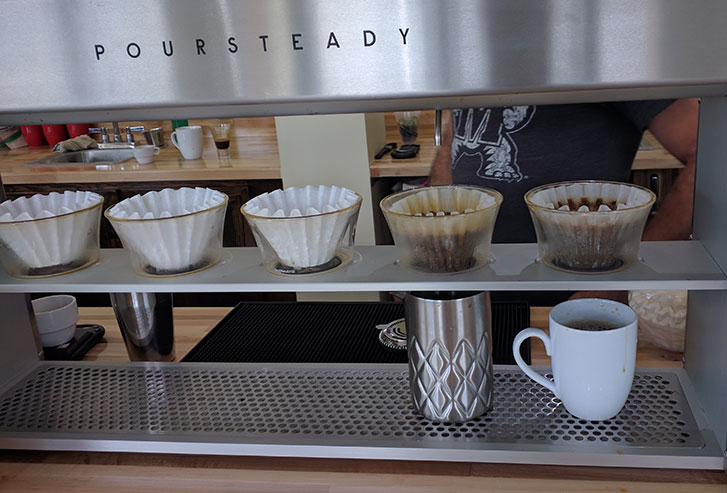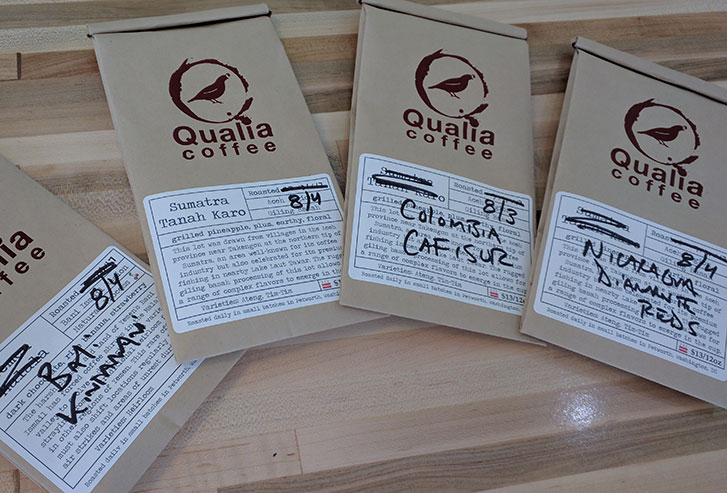Tropical stouts are a wonderful canvas for adding ingredients like coffee or cocoa. The smooth, rich flavors of the base beer can hold their own even while the new ingredient adds a dimension that makes it into its own unique beer. We plan a series of beers based on Chronicle, our Tropical Stout. Think Coffee Chronicle, Coconut Chronicle, Cocoa Chronicle, Cherry Chronicle and even Chipotle Chronicle. Some of these Chronicle variants will only be offered in our taproom, but we will also can and distribute some that prove most popular.
We recently collaborated with the good folks at Qualia Coffee to experiment with different coffees and approaches for making Coffee Chronicle. We then shared our approach and the results with the BADASS homebrew club to get feedback and help us refine our recipe. We also served two versions at the MASHOUT homebrew campout weekend. It turns out that Cinnamon-candied pecans pair really, really well with Coffee Chronicle!
 The Tropical Stout Style
The Tropical Stout Style
Chronicle is going to be one of Silver Branch’s four flagship beers. Tropical Stout was previously included in the Beer Judging Certification Program (BJCP) style guidelines under Foreign Stout, but was broken out as its own style in the 2015 revision. It is similar to Foreign Stout in that it is a rich stout with a malty, slightly sweet, and smooth roasty finish. It differs from Foreign Stout category in that often has mild toffee and rummy notes from added sugar, since it developed in tropical countries where sugar is usually produced (and is therefore cheap) and malt is not (and is therefore expensive). Dragon Stout, Royal Stout, and ABC Stout are some well-known examples.
Brewing Chronicle
For 11 gallons finished beer:
- 8 kg Pale Malt (Muntons)
- 6 kg Simpson’s Double Roasted Crystal (Special B would be a good substitution)
- 4 kg 60 L Crystal Malt (Muntons)
- 45 kg Chocolate Malt (Muntons)
- 35 kg Black Malt (Muntons)
- 35 kg Roasted Barley (Muntons)
- 35 kg piloncillo (unrefined cane sugar from Latin market)
- 47 grams HBC 472 experimental hop @ 9.4% aa (targeting 25 IBU)
- 3 grams pickling lime
- 3 grams gypsum
- 4 grams calcium chloride
- Fuller’s Yeast (I used WYeast 1968 but have also used WLP 002 with success)
I was shooting for a mash temperature of 155, but missed it significantly with a temperature of 151 (I’m still trying to relearn how to homebrew). I raised the temperature to 155 over 10 minutes. The total mash time was 35 minutes. No mash out was done for this beer. 3.3 grams of pickling lime was added to the mash to neutralize the acid from the significant amount of dark malts. 0.3 grams of gypsum and 3.4 grams of calcium chloride were added to the sparge water for additional calcium and to ensure the sparge pH didn’t rise too much.
After 10 minutes vorlauf, we collected 16 gallons of wort over 55 minutes. The boil was 90 minutes, and we collected about 11.5 gallons of wort. Summertime ground water temperatures made it necessary to put the wort into the refrigerator along with with four frozen gallons jugs of water to help chill the wort as quickly as possible.
A number of breweries that brew tropical stout use lager yeast fermented at ale temperatures. Some, however, use ale yeast, which is what we did for this batch. At some point we will do a side-by-side experiment to compare the same wort fermented with an ale versus lager yeast to see which we like better. We used Fullers yeast because we intend to use it as our primary ale yeast for British style beers and IPAs at Silver Branch. I pitched the yeast at 61 degrees and set the temperature to 64.5. After 3 days of fermentation, I raised the temperature to 70 degrees for a diacetyl rest.
By the way, 11 gallons is a stupid amount of finished beer for anyone using 5-gallon Cornelius kegs. I will formulate future recipes for multiples of 5 gallons.
Choosing a Coffee
Both of us have made coffee beers in the past, but Brett has researched and tried more approaches. In the course of discussing ways to infuse coffee into beer, we realized we needed to experiment to assess the different approaches. We especially wanted to explore how different approaches impact the ability to detect a specific coffee variety in the beer. We really wanted to find an approach and coffees that allowed the coffee varietal character to shine through, rather than have it perceived a generic “coffee” flavor. Many stouts already have strong coffee and chocolate flavors from the dark malts used. Why choose a coffee and an infusion technique that simply amps up flavors you can achieve with dark malts? For this reason, we were less interested in dark roasted coffees than in lighter-roast coffees with bright and distinct flavors and aromas that might prove noticeable even alongside a robust tropical stout.
Happily for us, Brett’s friend Joel, a fellow coffee nerd, commercial roaster and owner of Qualia Coffee was also intrigued and kind enough to offer to help us out. We took some of the stout down to Qualia’s Eckington location and met with Joel and Qualia’s head roaster. They had picked out 5 varieties for the tasting, each of which they prepared two ways—a pour-over hot coffee and a Japanese cold brew approach, which is a hot pour-over that drips onto ice to immediately cool it (the photo shows a traditional pour-over on the right and Japanese cold brew on the left). The idea behind the Japanese cold brew approach as opposed to a “dry bean” approach is that the hot water extracts flavors a cold extraction can’t, but the immediate cooling preserves aromas and volatile flavors that would escape if the coffee were left at a hot temperature. We combined the traditional pour-over and the Japanese cold brew of each variety with Chronicle. While both approaches allowed the varietal flavors to come through, in each case, we strongly preferred the Japanese cold brew as being a more pleasing combination of coffee and beer.
We tried four of the five coffees in the end, rejecting the Columbia Cafisur because Joel knew it was too similar to our least favorite coffee that we had tried earlier in the tasting. The four coffees we tried were a Costa Rican San Isidro, a Bali Kintamani Natural Process (whereby the coffee fruit is left on the bean to dry before eventually being removed), Nicaragua Diamante, and Sumatra Tanah Karo. The four coffees were quite distinct from each other, ranging from bright floral and fruity to earthy and vegetal/green pepper. The opinions on which coffees worked and which didn’t were surprisingly nearly unanimous. The least favorites were the natural process Bali, as the acidity from the bean interacted unpleasantly with the beer, and the Sumatra, where the earthy and green pepper flavors simply didn’t add a pleasant dimension to the beer. Of our two preferred coffees, the Costa Rican San Isidro won out over the Nicaraguan because it brought a more distinct character to the finished beer. Both were delicious, but the Costa Rican combination was just a bit more special.
Making Coffee Chronicle
Having chosen a coffee, it was time to do our infusion experiment. We decided to use three approaches: “dry beaning,” adding cold extract coffee, and adding Japanese cold brew. As a brewer, both the cold extract and Japanese cold brew made me nervous because I knew we would be adding oxygen to finished beer. However, for the purposes of the experiment, we forged ahead knowing that this beer would not sit around for weeks. We attempted to control variation wherever we could. We used 125 grams of coffee for each approach and ground the beans at the same grind setting, and made the same amount of finished beer in each case, which was a mostly-full three-gallon corny keg. We actually filled each keg by weight (9.5 kg) to ensure the amount of beer was consistent.
The dry beaning was the simplest. We ground the coffee, put it into a sanitized mesh bag and placed it into an empty keg, purged the keg with CO2, and pushed beer into the keg. The following day, about 28 hours later, we pushed the beer off the coffee into a different keg.
The cold brew was made by putting the ground coffee into a hop sack and allowing it to steep in the refrigerator with 32 ounces of water for the same amount of time as the dry bean beer before being put into a keg and having beer pushed in with it (yes, the coffee soaked up a lot of the water).
The Japanese cold brew was brewed with the same amount of total liquid as the cold extract including the ice the coffee was dripped in on top of (we measured the water by weight, making it easy to include the ice). The cold coffee was then immediately put into a keg and we pushed beer in with it.
The Results
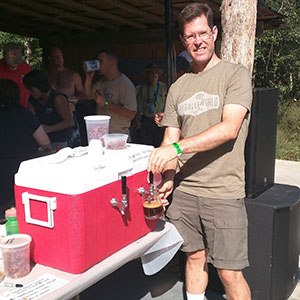
The coffee character was much more intense in the dry beaning. However, the varietal characteristics were muted when compared to the Japanese cold brew version. One important caveat, though, is that 28 hours is far too long. The coffee was over-extracted and some un-desirable bitter and vegetal flavors had been extracted. This may have overwhelmed some of the more subtle varietal characteristics.
The Japanese cold brew had a lighter coffee character, but the varietal flavors shone through surprisingly clearly. The bright lemony and other fruit flavors were quite apparent, as were some cedar wood aromas. We was quite surprised by the results from this approach to making coffee stout, and look forward to experimenting with other coffee varieties.
Conclusions and Next Steps
We came away from our coffee Chronicle experiment with a number of conclusions:
- It is possible to create coffee beer where varietal characteristics shine through even a robust beer like tropical stout.
- Both dry bean and Japanese cold brew approaches produce delicious coffee beer. Based on our taste tests, different drinkers preferred one over the other rather that one being better than the other.
- 28 hours is too long an extraction time for dry beaning, at least with the grind and volume of beer we were working with. Contact time and grind are areas of future experimentation for us.
In end, we envision producing a “dry beaned” version of Coffee Chronicle for distribution, since we can minimize oxygen pick up with this approach. But we loved the Japanese cold brew version so much that we will periodically make batches of it with different coffee varieties and make it available as a taproom-only offering.
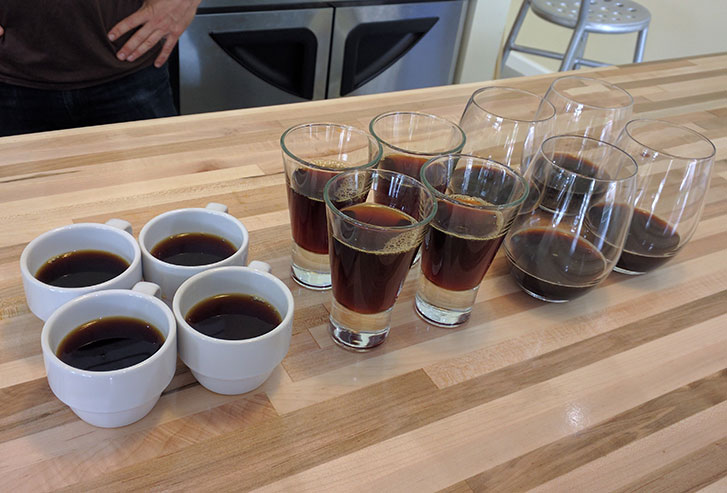
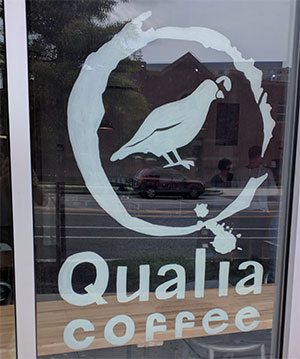 The Tropical Stout Style
The Tropical Stout Style